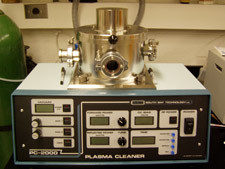Equipment
Plasma Cleaner

Model:
South Bay Technology Plasma Cleaner
Capabilities:
This tool is capable of plasma processing small and large samples to selectively dry etch organics from surfaces. Specific application is in removing hydrocarbons from TEM sample rods to diminish contamination in the microscope. It can also be used to remove carbonaceous materials from samples (e.g. wafers with photoresist), as well as other materials.
Cost:
Calendar for Reservations:
Specifications:
- up to 6" samples.
- both oxygen and argon gases for plasma.
- RF plasma generator.
- simple timed operation.
On-line Manual:
(from Wikipedia)
Plasma cleaning involves the removal of impurities and contaminants from surfaces through the use of an energetic plasma created from gaseous species. Gases such as argon and oxygen, as well as mixtures such as air and hydrogen/nitrogen are used. The plasma is created by using high frequency voltages (typically kHz to >MHz) to ionize the low pressure gas (typically around 1/1000 atmospheric pressure), although atmospheric pressure plasmas are now also common.
If the gas used is oxygen, the plasma is an effective, economical, environmentally safe method for critical cleaning. The plasma energy is very effective in the breaking of most organic bonds (i.e., C–H, C–C, C=C, C–O, and C–N) of surface contaminants. This helps to break apart high molecular weight contaminants. A second cleaning action is carried out by the oxygen species created in the plasma (O2+, O2-, O3, O, O+, O-, ionized ozone, metastable excited oxygen, and free electrons). These species react with organic contaminants to form H2O, CO, CO2, and lower molecular weight hydrocarbons. These compounds have relatively high vapor pressures and are evacuated from the chamber during processing. The resulting surfaces are ultra-clean.
